Page 159 of 516
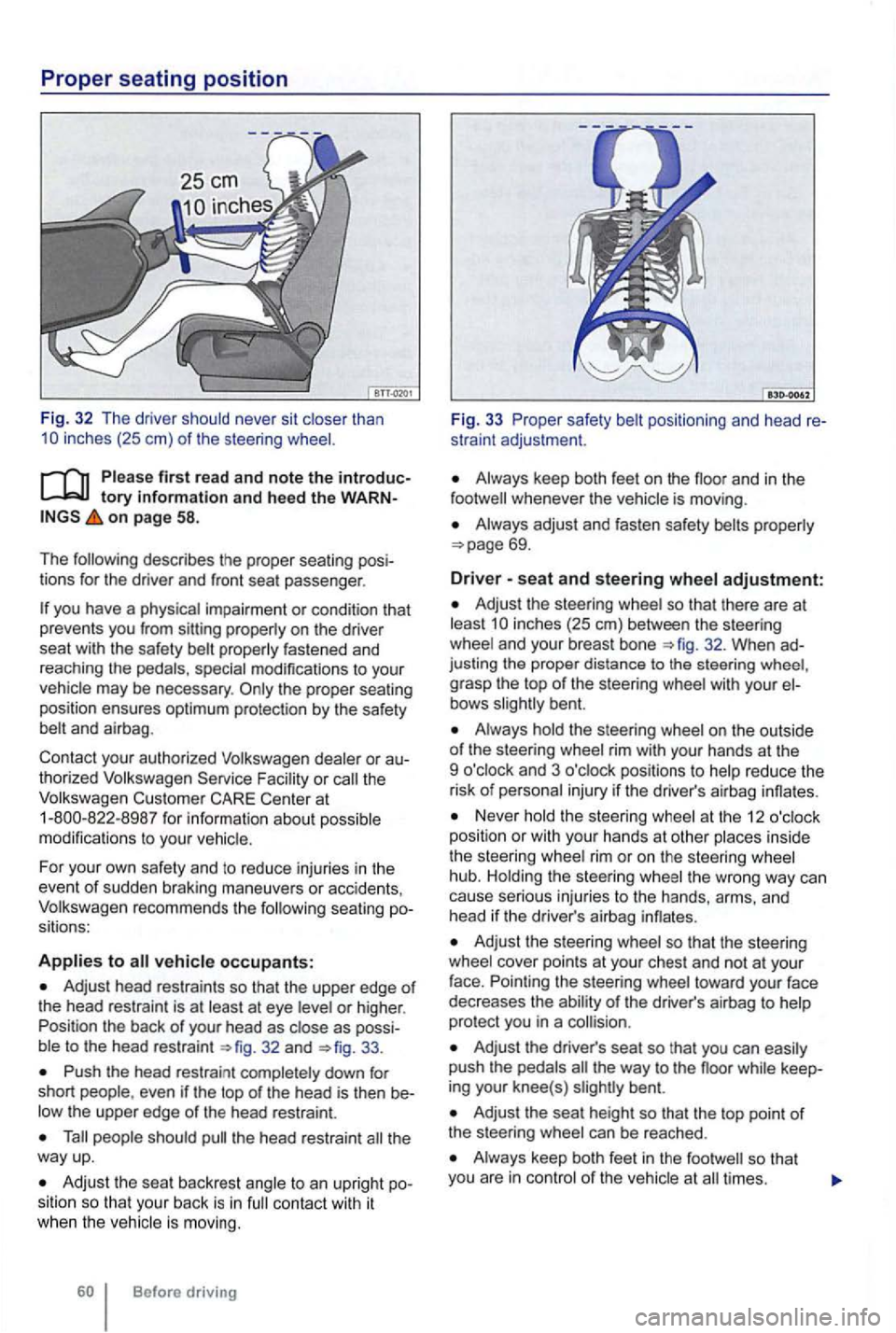
first rea d and note the introductory information and hee d the WARNon page 58.
The following describes the proper seating posi
tions for the driver and front seat passenger .
special modifications to your
vehicle may be necessary .
to
Adjust head restraints so that the upper edge of the head restraint is at least at eye
32 and 33.
Push the head restrai nt completely down for
short even if the top of the head is then be
people should the head restraint the way up.
Adjust the sea t backrest angle to an upright position so that your back is in contact with it when the veh icle is moving.
Before driving
Fig. 33 P roper safety
Always keep both feet on the whenever the vehicle is moving .
Always adjust and fasten safety belts properly
adjustment:
Adjust the steering whe el so that there are at least inches (25 em) between the steeri ng
wheel and your breast bone
grasp the top of the steering wheel with your bent.
Always hold the steering wheel on the outside of the steering wheel rim with your hands at the
9 o'clock and 3 o'clock positions to help reduce the
risk
of personal injury if the driver's airbag innates.
Never hold the steering wheel at the 12
and
head if th e driver's airbag innates.
Adjust the steering wheel so that the steering
wheel cover points at your chest and not at your
face. Pointing the steer ing wheel toward your face
dec reases the ability
of the driver's airbag to help
protec t you in a
Adjust the driver's seat so tha t you can easily push the pedals the way to the noor while keep
ing your knee(s) bent.
Adjust the seat height so that the top point o f
the steering wheel can be reached .
Always keep both feet in the times.
Page 164 of 516
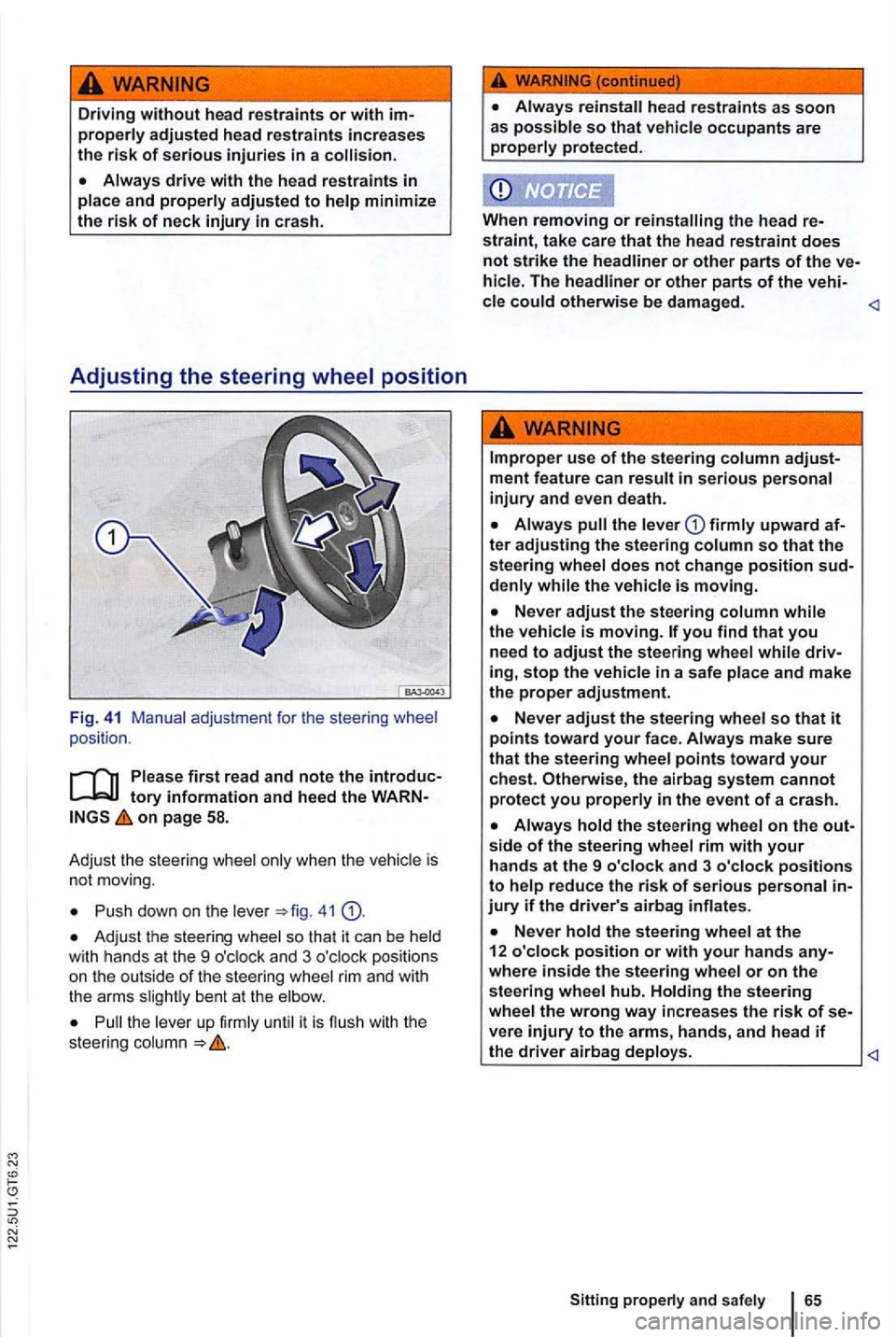
Driving without head restraints or with properly adjusted head restraints increases
the risk of serious injuries in a
tory information and heed the on page 58.
Adju st the steerin g whee l only w he n the veh icl e is
no t m ovi ng.
Push dow n o n the leve r 41
Adj ust th e steering whee l so th a t it ca n b e held w ith hands at the 9 o'cloc k and 3 o 'clock positio ns
o n the out side of the steering wheel rim and with
t he arms slightl y b ent at the elbow .
Pull the leve r up firml y until it is flu sh with th e
stee ring colum n
the lever
denly while the vehicle is moving.
Never adjust the steering wheel so that it points toward your face . Always make sure that the steering wheel points toward your chest. Otherwise, the airbag system cannot protect you properly in the event of a crash.
side of the steering wheel rim with your hands at the 9 o'clock and 3 o'clock positions to help reduce the risk of serious personal
where inside the steering wheel or on the steering wheel hub. Holding the steering wheel the wrong way increases the risk of vere injury to the arms, hands, and head if the driver airbag deploys.
Page 166 of 516
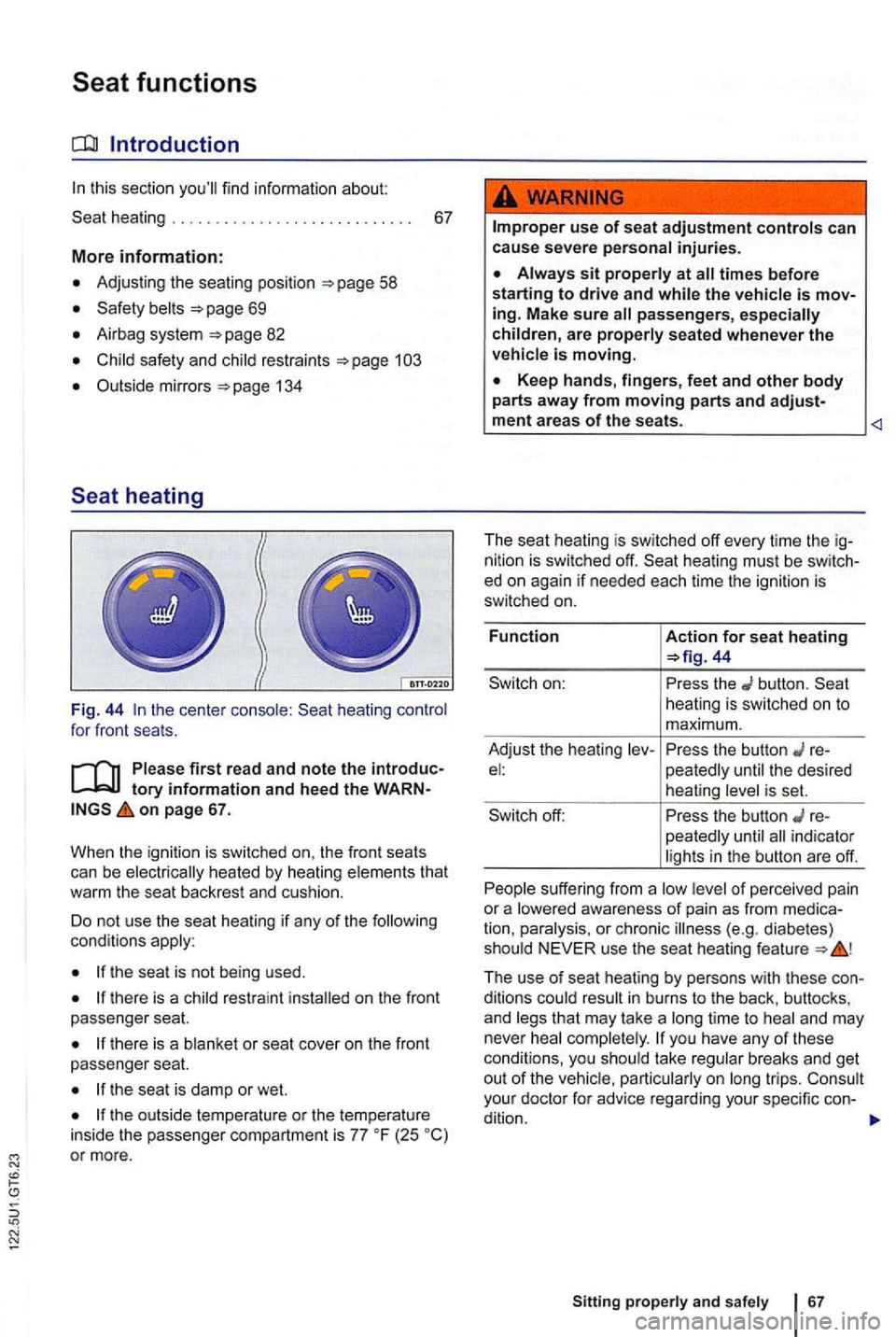
this section find information about:
. . . 67
More information:
Adjusting the seating position 58
69
Airbag system page 82
safety and restraints
Outside mirrors 134
the cente r heating for front seats.
on page 67.
When the igni
tion is sw itched on, the front seats
can be that
wa rm the seat backrest and cush ion .
Do not use the seat heating
if any of the cond itions
the sea t is not being used.
on the front
passenger seat.
there is a or seat cover on the front
passenger seat.
the seat is damp or wet.
(25 or more .
use of seat adjustment controls can
cause severe personal injuries.
passengers, especially
children, are properly seated whenever the
44
button. heating is sw itched on to
m aximum.
Adjust the hea ting
re-the desired
heating
the button re
peatedly indicator
s uff ering from a of perce ived pain
or a
The use of seat heating by persons with these conditions time to and may
never
take breaks and get out of the trips. your docto r fo r advice rega rding your specific con-
dition.
Sitting a nd 67
Page 168 of 516
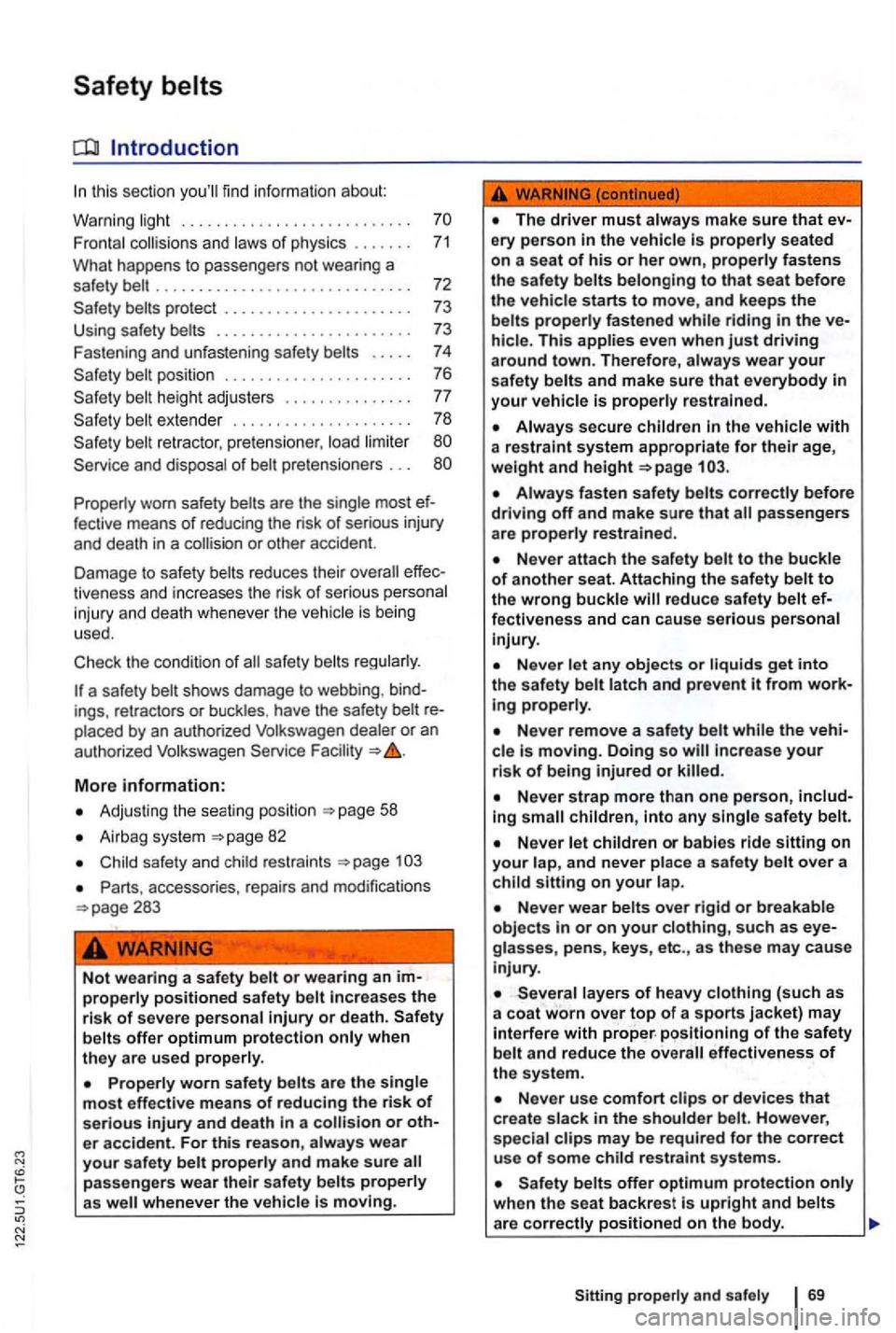
find informati on about:
Fro nt al
Properly worn safety fective means of reducing the risk of serious injury
and death in a or othe r accident.
D amage to sa fety belts reduces their
tiveness and increases the risk of se rious personal
i nj ury and death whenever the vehicle is being
used .
Check the conditi on of
a safe ty belt shows damage to webbing , ings, retracto rs or buckles . have the safety belt
More information:
Adjusting the seating posit io n
Airbag system
Child safety and child restraints 103
Parts , access ories, repai rs and modifications
Properly worn safety belts are the single most effective means of r educing the risk of serious injury and death in a collision or er accident. For this reason , always wear your safety belt properly and make sure all
pa ssengers wear their safety belts properly as well whenever the vehicle
The driver must always make sure that
hicle. Thi s applies even when just driving around town. Therefore, always wear your safety belts and make sure that everybody in your vehicle is properly restrained.
Always secure children
Always fasten safety belts correctly before driving off and make sure that all passengers
are properly re strained .
Never attach the safety belt to the buckle of another seat. Attaching the safety belt to the wrong buckle will reduce safety belt fectiveness and can cause serious personal injury.
cle is moving. Doing so will
small children, into any single safety belt.
Never wear belts over rigid or breakable objects in or on your clothing, such as glasses, pens, keys, etc., as these may cause injury.
layers of heavy clothing (such as
a coat worn over top of a sports jacket) may with proper. positioning of the safety belt and reduce the overall effectiveness of the system .
Never use comfort clips or devices that create slack in the shoulder belt. However,
s pecial clips may be required for the correc t
u se of some child res traint systems.
Page 171 of 516
What happens to passengers not wearing a safety
driver is thrown forward.
tory and hee d the WARN on p age 69 .
Many
That is
in
the seat with the arms and hands . a into
the steering instrument in the way 48.
Never on airbags airbags provide protection. Airbags are not supposed to in kinds of accidents. Even if your
Befo re driving
Fig . 4 9 passengers in the rear seats are
th rown forward on top of the
in orde r
to min imize the risk of severe injury or death in a
crash , regardless
of whether a seating position has
an airbag or not.
An airbag
is since they can
be thrown forwa rd through the passengers in the rear seats endanger not but the driver and other passengers in the 49.
Page 172 of 516
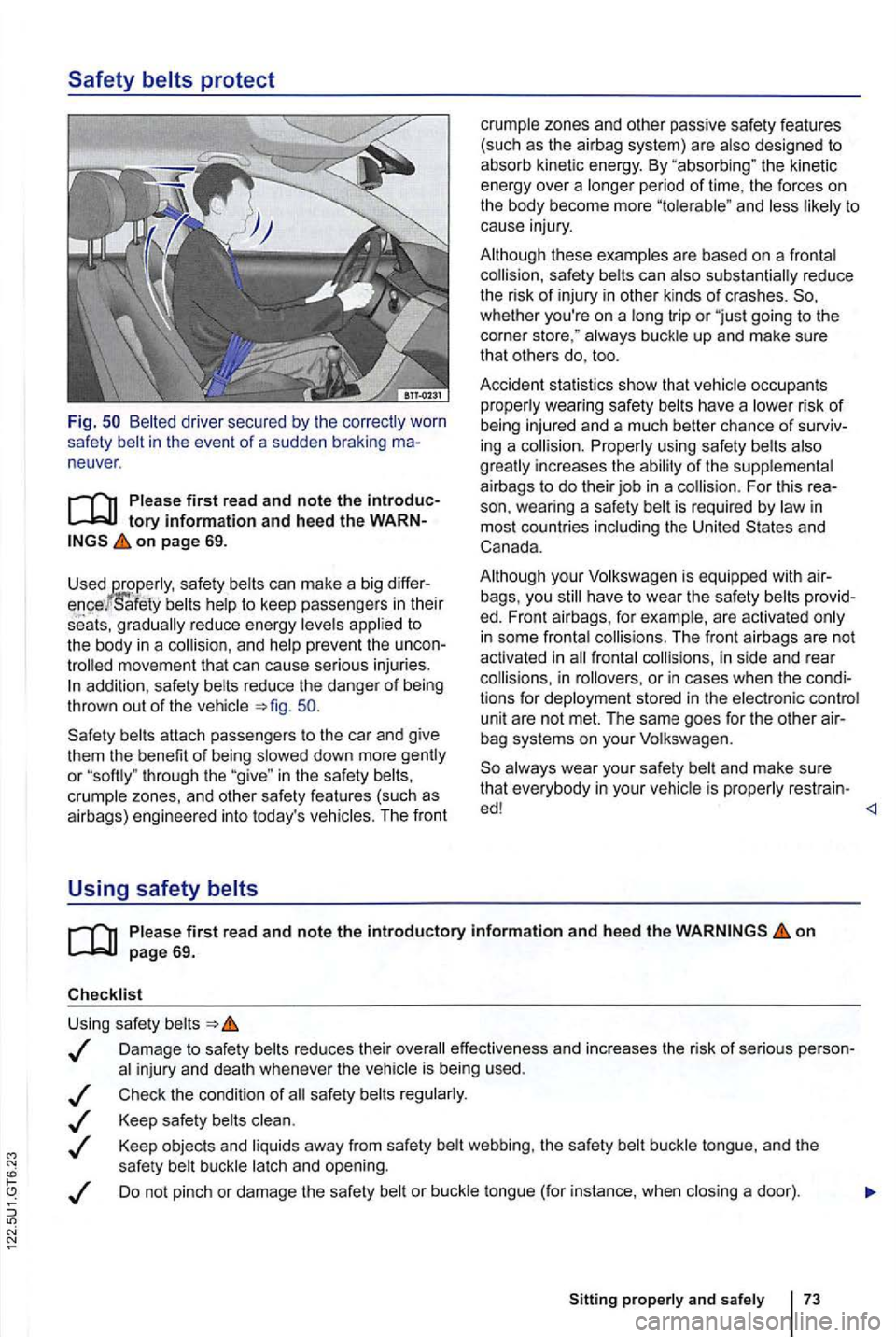
Safety belts protect
Fig. Belted driver secured by the
neuver .
on page 69.
Used safe ty can make a big
to
the body in a co llision , and help prevent the
addition , safe ty reduce the danger of being
thrown out of the vehicle
or through the in the safety crumple zones, and other safety features (such as
airbags) engineered into today's The front
Using safety belts
crumple zones and other passive safety features
(such as the airbag system) are also designed to
absorb kinetic energy. By "absorbing " the kinetic
energy over a longe r pe riod
of time, the forces on
the body become more to
cause injury.
Although these examples are based on a fronta l
collision , safety
whether you're on a long trip or "just going to the
corner always buckle up and make sure
that others do, too.
Accident statist ics show that vehicle occupants
p roperly wearing safety
also
g reatly increases the ability of the supp lementa l
airbags to do thei r job in a collision. For this is required by in
most countries including the United
your Volkswagen is equipped with have to wear the safety
bag systems on your Volkswagen.
always wear your safety is properly restra in -
ed!
o n
Damage to safety reduces their overall effectiveness and increases the risk of serious injury and death whenever the
Check the condition of
webbing , the safety buckle tongue, and the
safety buckle latch and opening.
Do not pinch or damage the safety
Page 175 of 516
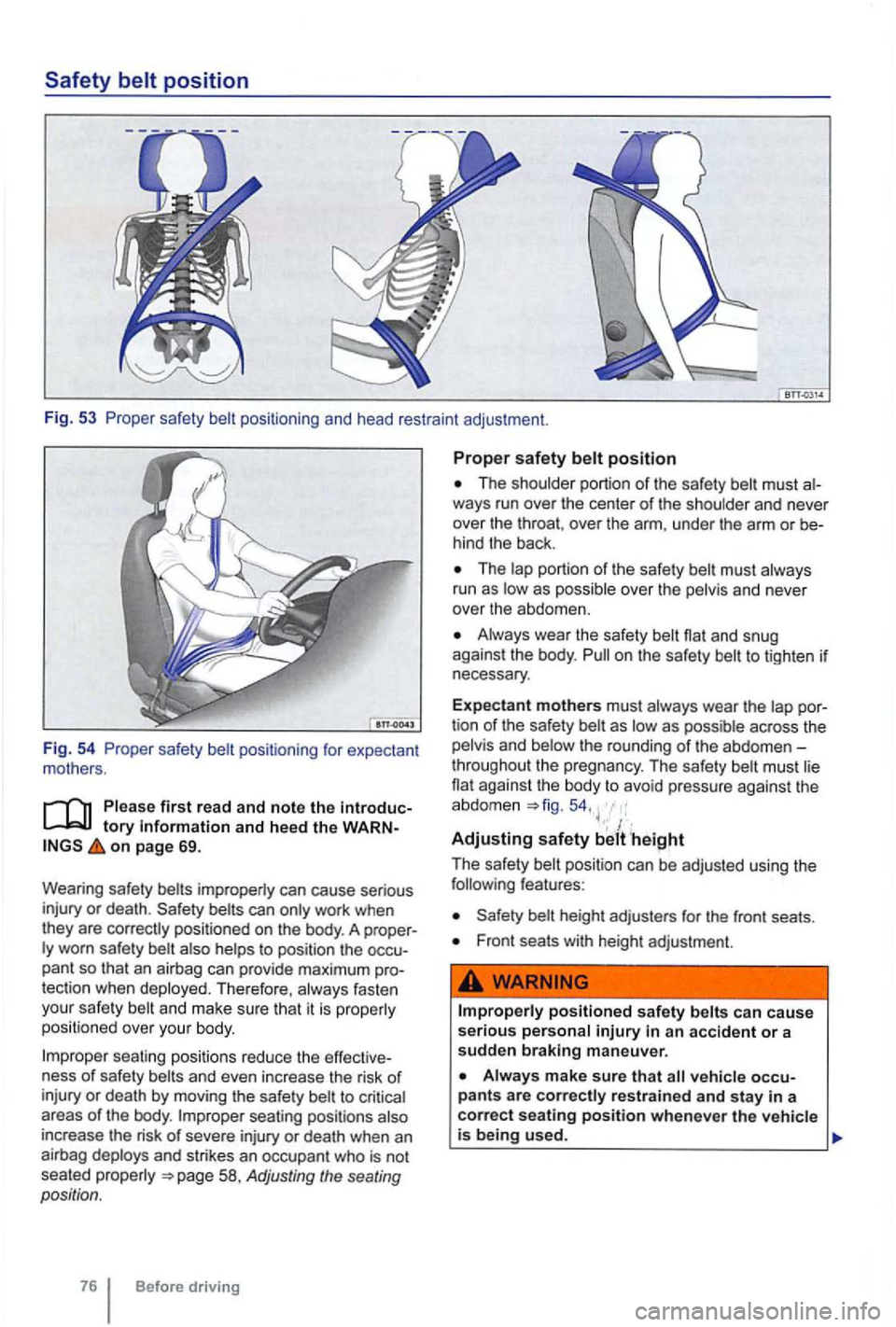
Please first read and note the
on page 69.
Wearing safety belts improperly can cause serious
injury or death.
ly worn safety belt also helps to position the pant so that an airbag can provide maximum tectio n when deployed. Therefore, a lways fasten
your safety
sea tin g positions reduce th e ness of safe ty belts and even increase the risk of injury or d eath by mov ing the safety belt to critical
areas of the body. seating positions also
inc rease the risk of sev ere injury or death when an
airbag deploys and strikes an occupant who is not
seated properly
The shoulde r portion of the safety belt must
hind the back .
The lap portion of the safety belt must always
run as low as possible over the pelvis and neve r
over the abdomen.
Always wear the safety belt
tion of the safety belt as low as possible across the
pelvis and below the rounding of th e abdomen -
throughout th e pregnancy . T he safe ty belt must lie
54.
Adjusting safety
The safety belt posi tion can be adjusted using the
following features:
Front seats with heigh t adj ustment.
positioned sa fety belts can cause serious personal injury a n accident or a
sudde n braking maneuver.
Always make sure that vehicle
Page 177 of 516
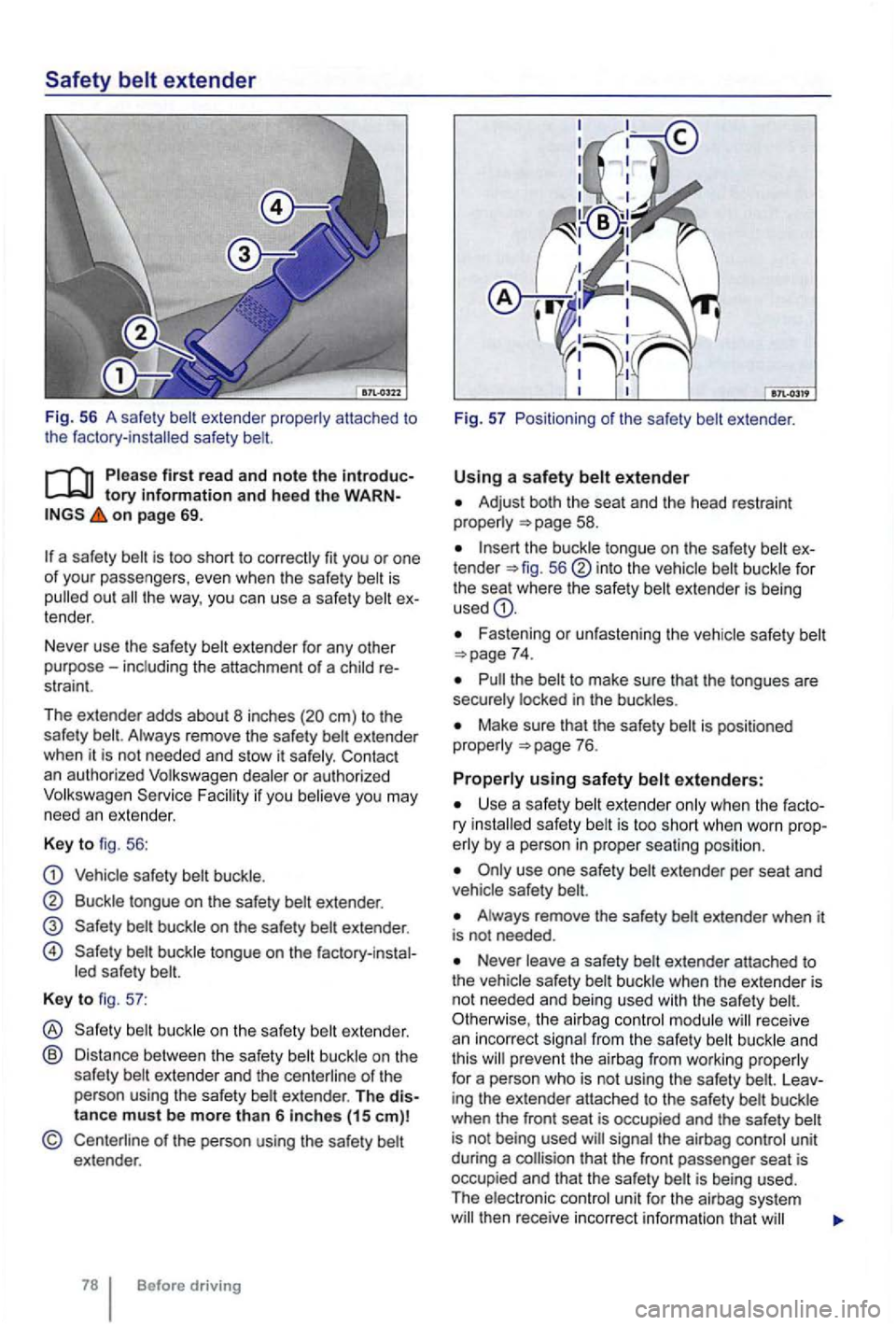
Safety
extender
first read and note the introduc
on page 69.
out the way, you can use a safety
extender for any other
purpose
em) to the
safety remove the safety Contact
an authorized or au thorized if you
tongue on the safety
tongue on the factory- instal-
Key to fig . 57 :
extender.
@ Distan ce between the safe ty on the
safety ex tender and the extender . The
extender
Adjust both the seat and the head restra int 58.
the tong ue on the safe ty 56 for
the seat where the safety extende r is being
used
F as teni ng or u nfastening the
the to make sure that the tongues are
Make sure that the safety is posi tioned
extenders:
Use a sa fe ty extender ry safety
use one safety
Never when the extender is
not needed and being used with the safety
Otherw ise, the airbag receive
a n in cor rect
for a person who is no t using the safe ty ing the extender attached to the safety
is not being used the airbag that the fron t passenger seat is
occupied and that the safety unit for the airbag system then receive incorrect informatio n t hat